On
their own turn a player
must undertake one of the following three actions:
- Play a keyper
- Play a keyple
- Lay down a keyple(s)
There are also opportunities to:
- Play a keyple on another player's turn
|
When first played (points 1, 2 and 4 above) a keyper or keyple is always placed standing up.
|
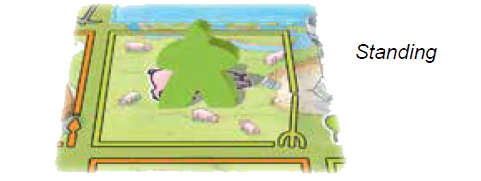
|
|
Under action 3 a keyple may be laid down by placing it on its side.
|
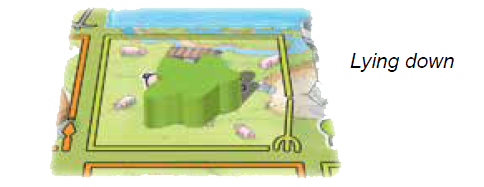
|
When playing or laying down a keyple it is always optional as to whether a player takes any action or resource generated.
Whilst the procedures for performing these actions may look complicated at first,
players should find them logical and straightforward once they are familiar with them.
The main options available from these actions are to:
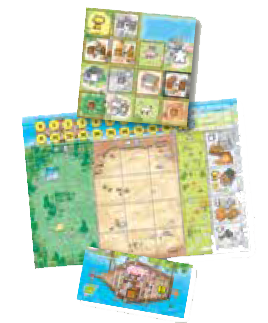
-
gather resources and acquire building tiles from the fields on the country boards,
-
build, up-grade and utilise building tiles on the player's own player board,
-
work on a boat in order to gain resources and/or ship resources for points
Players will also want to save resources for game-end scoring purposes.
Play proceeds in a clockwise direction until all players have played their keyper and all of their keyples, at which point the
end of the season
is triggered.
There are four seasons in the game:  ,
,  ,
,
 and
and  .
The game ends
at the end of the
.
The game ends
at the end of the  season.
season.
1. Play a keyper
-
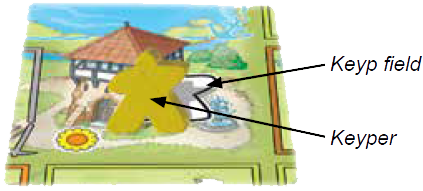 Once per season as their action and at any time a player must play their keyper from the keyp
on their player board onto an empty keyp field on one of the country boards.
Once per season as their action and at any time a player must play their keyper from the keyp
on their player board onto an empty keyp field on one of the country boards.
-
The effect of playing the keyper is to claim the country board that the keyper has been placed on. At end of the season the player will take that country board, together with all of the keyples that are on that country board. At the end of
 ,
,
 and
and
 these keyples will from part of the player's new team of keyples for the following season, and at the end of
these keyples will from part of the player's new team of keyples for the following season, and at the end of
 they will be available for game end scoring purposes.
they will be available for game end scoring purposes.
Claiming a country board does not prevent other players from playing keyples onto that country board.
-
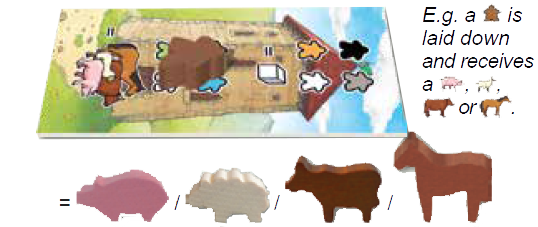 When a player plays their keyper, then they also lay down any keyples that are on their keyp tile.
For each keyple that is laid down the player gains one of the resources (if available) indicated on the keyp tile. A
When a player plays their keyper, then they also lay down any keyples that are on their keyp tile.
For each keyple that is laid down the player gains one of the resources (if available) indicated on the keyp tile. A
 ,
,
 ,
,
 or
or
 keyple gains a raw material
keyple gains a raw material
 . A
. A
 ,
,
 ,
,
 or
or
 keyple gains a
keyple gains a
 ,
,
 ,
,
 or
or
 .
.
Note that there will be no keyples on the keyp tiles in
 . Keyples are only placed on the keyp tiles at the start of the
. Keyples are only placed on the keyp tiles at the start of the
 ,
,
 and
and
 seasons.
seasons.
-
If a player has not yet played their keyper then they cannot undertake action 3 (iii): lay down a keyple.
2a. Play a keyple
|
A keyple is played from the keyp area of the player's board.
|
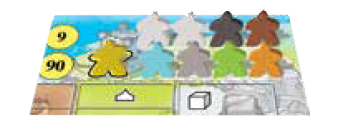
|
|
Any coloured keyple may be played onto either a field on any country board, or a plot
that contains a building tile on the player's own player board.
|
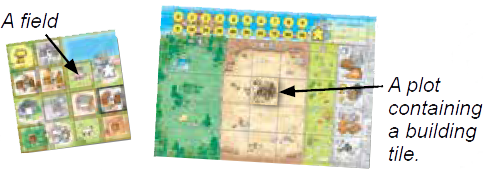
|
|
The field or building tile must either be empty or contain only one keyple, known as an existing keyple.
|
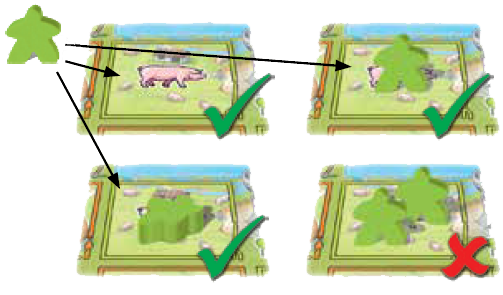
|
|
On its own, a keyple generates a single action or resource. Some fields (but no plots) have a coloured border.
If a keyple is played onto a field that has a coloured border that matches the keyple's colour then the keyple is working in its area of
expertise and the keyple generates a second action or resource.
|
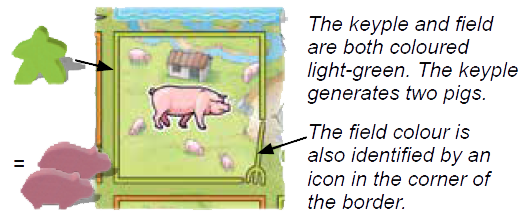
|
A player may play on a country board even if it has been claimed by a keyper, either the player's own keyper or an opponent's keyper.
A keyple cannot be played onto:
-
a keyp field on a country board (where only the keypers are played)
-
a keyp tile
-
an opponent's player board, or
-
a field (including the double sized river space) or plot that already contains two keyples
Once a keyple has been played it no longer belongs to the player who played it. Its previous ownership does not need to be tracked.
2b. Joiners
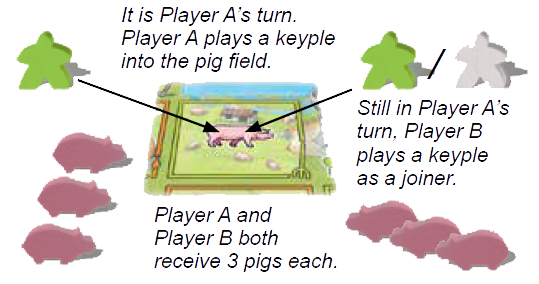 If a field is empty when a keyple is placed on it, the player ('Player A') must invite the other players to place a keyple
onto the same field in order that they can join Player A's keyple. As there is a limit of two keyples per field, only one other player can play a 'joiner'.
If a field is empty when a keyple is placed on it, the player ('Player A') must invite the other players to place a keyple
onto the same field in order that they can join Player A's keyple. As there is a limit of two keyples per field, only one other player can play a 'joiner'.
The player to Player A's left, Player B, gets the first option to join Player A by placing one of their keyples into the same field.
If Player B declines, then in clockwise order, the other player(s) (if any), get the same option to join.
The joining keyple must be either the same colour as the keyple played by Player A, or a white keyple (which can represent any colour).
If another player plays a keyple as a joiner, then Player A's and the joiner's keyples will work together and both keyples will generate an additional action or resource.
| Number of actions or resources received by: | Player A (if no joiner) | Player A and joiner |
|---|
| If no colour match | 1 | 2 |
| If keyple and field colours match | 2 | 3 |
The keyple played by a joiner does not have to take the same action(s) or resource(s) as the player whose turn it is.
If a white keyple has been played on a coloured field, then the white keyple is deemed
to be specialising in the colour of that field and can be joined by either a white keyple or a keyple of the field's colour.
A white keyple played on a field with no colour or a plot can only be joined by another white keyple.
2c. Existing keyples
All keyples have the potential to work twice in each season. To indicate when a keyple has worked for a second time it is laid down.
If the field or plot already contains a keyple (known as an 'existing keyple') from a previous turn, then the keyple being played (by Player A) may become a joiner.
As a joiner the keyple must either be the same colour as the existing keyple or a white keyple.
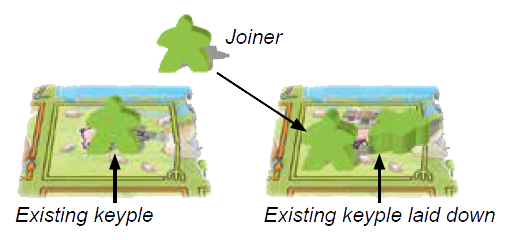 The existing keyple may now be laid down to indicate that it is working for a second time and in order to generate an additional action or resource.
(Occasionally it can be advantageous not to lay down an existing keyple in order to facilitate a lay-down opportunity on a later turn.)
The existing keyple may now be laid down to indicate that it is working for a second time and in order to generate an additional action or resource.
(Occasionally it can be advantageous not to lay down an existing keyple in order to facilitate a lay-down opportunity on a later turn.)
It is permissible to join a keyple that is already lying down.
In these circumstances the lying down keyple cannot work again (for a third time) and the joiner gets the same benefit as if they were working on their own in an empty plot.
The number of resources or actions received by Player A are as follows:
|
Existing keyple:
|
Is laid down as part of action
|
Choose not to lay down (or was already laid down on a previous turn)
|
| If no colour match
| 2 | 1 |
| If keyple and field colours match | 3 | 2 |
If a white keyple is played as a joiner, it counts as the colour of first keyple played, not the colour of the field
(when the colour of the first keyple played is different from the colour of the field).
If the existing keyple is a white keyple and that white keyple has been played on a coloured field,
then the joiner can be a white keyple or a keyple of the same colour as the field. If the existing white keyple
is on a plot or a field with no colour then the white keyple can only be joined by another white keyple.
The actions of an existing keyple and a joiner do not need to be the same action. See the following examples:
-
A light-blue keyple is played onto a boat tile where there is an existing light-blue keyple. The existing light-blue keyple is laid down.
There are three actions available. The possible actions are
-
to work for resources
-
to sell resources
-
to work for one type of resource offered by the boat and to sell the other type of resource.
-
The keyple being laid down could be used to upgrade a tile that it is on, if applicable, and the keyple being placed to take the action on the upgraded tile.
-
If using the upgraded builder tile, the existing keyple could be laid down and used to build a building tile, the joiner could then upgrade the same tile.
3. Lay down a keyple(s)
A keyple may only be laid down when:
-
it is an existing keyple in a field or plot and it is joined on a later turn by another keyple.
-
it is a keyple on a keyp tile that is laid down when the player's keyper is played.
-
a player has no keyper/keyples left in the keyp on their player board when it is their turn to
play and one or more of the other players has a keyper or keyples still to play. If possible, the keyple(s) being laid down must be on either:
-
a plot on the player's own player board
-
a field on the country board that the player has claimed with their keyper.
The following rest of this section relates to the situation in (iii) above.
The field or plot chosen must contain at least one keyple that has not already been laid down.
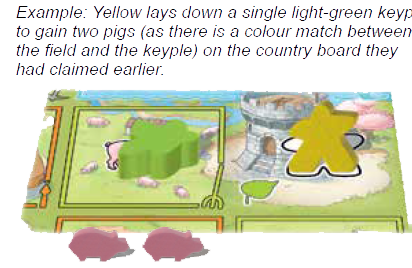 If there is just a single keyple standing in the field or plot, then the player may lay that keyple down to denote that the keyple is working for a second time,
and then gain one action or resource (or two if there is a colour match between the keyple and the field).
If there is just a single keyple standing in the field or plot, then the player may lay that keyple down to denote that the keyple is working for a second time,
and then gain one action or resource (or two if there is a colour match between the keyple and the field).
If there are two keyples still standing, then the player (Player A) may lay down either one, or more usually, both keyples:
one keyple as their turn and the second as a joiner. This denotes that both the keyples have now worked for a second time.
The first keyple, assisted by the joiner, gains two actions or resources (or three if there is a colour match).
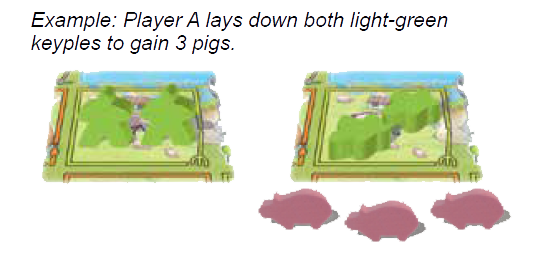 The joiner does not generate additional actions or resources for itself as it is only helping the other keyple laid down by the player.
The joiner does not generate additional actions or resources for itself as it is only helping the other keyple laid down by the player.
If there are two keyples and one of the keyples is already lying down (as it has already worked twice),
then the player may lay down the second keyple in order to denote that this keyple has also worked for a second time and gain
the action or resource (or two if there is a colour match).
The number of actions or resources that Player A gets from laying down a keyple or 2 keyples are as follows:
|
Number of keyples laid down:
|
1
|
2
|
| If no colour match | 1 | 2 |
| If keyple and field colours match | 2 | 3 |
If on Player A's turn, all of the keyples on their player board and the country board they have claimed with their keyper have been laid down
(even if laying them down does not benefit Player A), then Player A may lay down keyples on one of the other country boards, even if that board
has been claimed by another player's keyper.
In these circumstances, re-check the position in each subsequent turn. If another player has subsequently played
onto the country board claimed by Player A, then player A will have to lay that keyple down before they can again lay down keyples on another player's board.
In the unlikely situation that there are no keyples to lay down, then the player does not take an action this turn.
4. Play a keyple on another player's turn
If a player (Player A) plays into an empty field, then Player A must invite the other players to place a keyple into the same field in order to 'join' their keyple.
Firstly the player to Player A's left, Player B, gets the option to join Player A by placing one of their keyples into the same field.
If Player B declines, then in clockwise order, the other player(s) (if any), get the same option to join.
The joining keyple must be either the same colour as the keyple played by Player A or a white keyple (which can represent any colour).
The two keyples work together as a team and are more productive. Both keyples are working for the first time, so neither keyple is laid down.
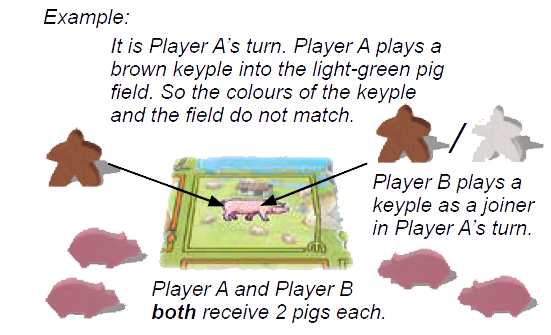 Both keyples generate two resources or actions each if there is no colour match with the field.
Either because the field is a different colour to the keyples or the field is not associated with a colour.
One action or resource as this is the keyple's basic production. A second action or resource as the two keyples are more productive working together.
Both keyples generate two resources or actions each if there is no colour match with the field.
Either because the field is a different colour to the keyples or the field is not associated with a colour.
One action or resource as this is the keyple's basic production. A second action or resource as the two keyples are more productive working together.
If there is a colour match then both keyples are working in their area of expertise and both keyples will generate three actions or resources.
If a white keyple is the joiner it assumes the colour of the first keyple, not the colour of the field if that is different.
The rewards that both Players A and B get from Player B's keyple joining Player A's keyple on Player A's turn are summarised as follows:
| If no colour match | 2 |
| If keyple and field colours match | 3 |